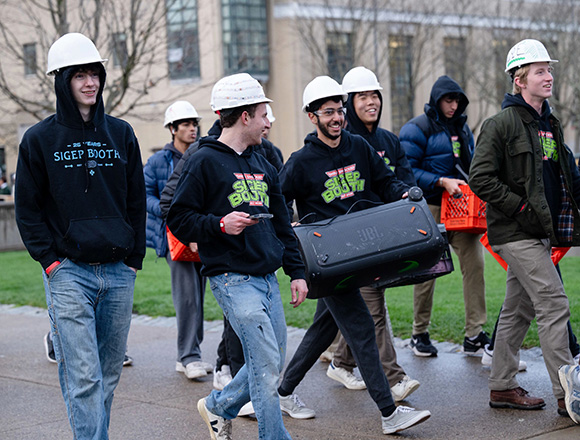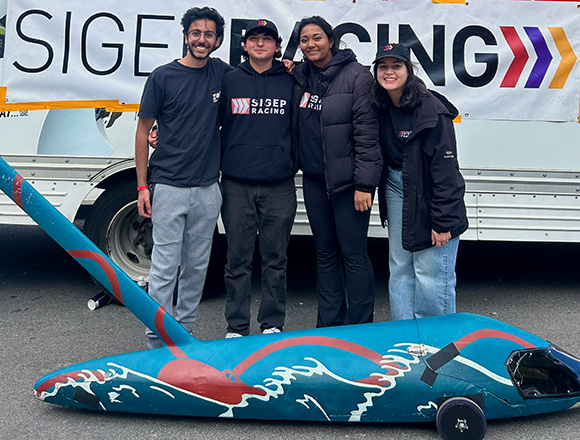Student spotlight: Bilal Chaudhry
Lauren Smith
Aug 7, 2024

Source: Bilal Chaudhry
The summer before his first year at Carnegie Mellon, Bilal Chaudhry registered for Introduction to Chemical Engineering because he liked chemistry. "Then I found out there was very little chemistry," he laughs. Instead, Chaudhry enjoyed the design and process elements of the course.
Now a chemical engineering major with an additional major in biomedical engineering, he has found the most value in how his engineering courses are teaching him to think. "We are consistently challenged to solve problems. Sometimes it's a homework problem that takes hours, and sometimes it's an exam problem that needs to be solved in minutes," says Chaudhry.
Chemical Reaction Engineering has been one of his hardest classes, and one of his favorites. Chaudhry liked seeing the intersection of coding and chemical engineering fundamentals–in the class, he used Python to model reactors and visualize the change in reactants over time.
This summer, Chaudhry is drawing on his biomedical engineering courses as an Engineering Summer Program Intern at Memorial Sloan Kettering Cancer Center. He is researching the biological function of prostate specific membrane antigen (PSMA) under various conditions. Current research indicates that PSMA is exclusively found on tumor vasculature, not in human tissue. As such, the research could contribute to the potential use of PSMA as a novel target for cancer therapies.
Chaudhry is specifically looking at how the presence or lack of PSMA changes tumor vasculature at varying levels of oxygen in the tissue. "In a solid tumor, the core doesn't get as much oxygen as the outside. To fully understand the behavior and growth of a tumor, we need to understand how its vasculature develops depending on the oxygen level," he explains.
At Memorial Sloan Kettering, Chaudhry also attends lectures by cancer researchers from across the country. "I've understood more of what I was listening to because of the classes I took at CMU," he says. One researcher presented an optimization problem for a heuristic model to trace where cancer metastases come from. "The other interns around me were a little lost, but I could follow because of my optimization class," says Chaudhry.
The experience of working at a top-ranked cancer center is made even better for Chaudhry by its location in New York City. He's just a subway ride away from many friends who have internships in different industries.
These include some of his Sigma Phi Epsilon brothers. Chaudhry joined the chapter his first year at CMU and immediately found a home there. "So many different things became possible for me because I am in the Greek community," he says. He has been a mechanic on the SigEp buggy team for the past three race days and has helped to build three booths, winning first place in the fraternity division each year. As president of the Interfraternity Council, Chaudhry is dedicated to helping others make the most of their experience.
His senior year experience will include continuing his research with Jim Schneider, professor of chemical engineering. They are creating higher throughput quality analysis methods for mRNA lipid nanoparticle (LNP) vaccines. The COVID-19 vaccine is one example of an mRNA LNP vaccine, and brought to light the bottlenecks in current production processes. "There are many different quality checks that a vaccine needs to go through before it gets put into the human body," explains Chaudhry. "That's a good thing, but it's currently an inefficient process.
Chaudhry uses stopped-flow spectrometry to study the kinetics of chemical reactions in solution. He is looking at how the kinetics of the mRNA release change depending on the composition of the lipid nanoparticle shell.
"Our initial goal was to detect certain contaminants or the lack of a lipid, but we didn't see noticeable changes," he says. Instead, the researchers ended up creating a faster way to measure the encapsulated fraction of mRNA. This measurement is very important in industry. "The mRNA needs to be encapsulated by the lipid shell in order for it to actually get delivered to the target body part," explains Chaudhry. The current assay to measure encapsulated mRNA takes a long time, is expensive, and requires someone specially trained. The spectrophotometry technique being developed in the Schneider lab is much faster and can also detect aggregation of the nanoparticles when the balance of lipids in the nanoparticle is not quite right.
Because of his research in the Schneider lab, Chaudhry is planning to apply to Ph.D. programs. Whether in academia or industry, he is motivated to be at the forefront of chemical and biomedical engineering, trying new and untested ideas to solve problems.




